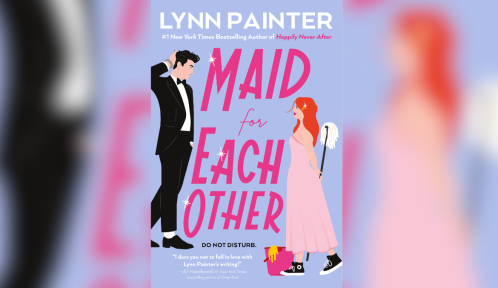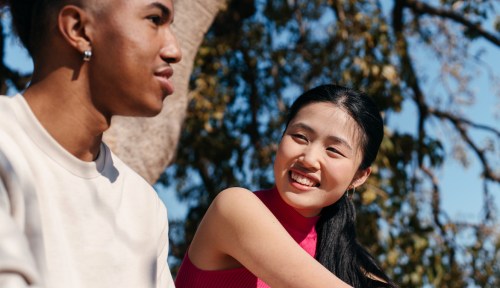The 5 Flirting Styles—How to Use Yours to Communicate Desire and Transform Your Dating Life
Flirting with someone isn't always easy. Experts explain how to flirt authentically with someone you have a crush on in person and over text.

Most people are aware of the five love languages, but did you know there are also five flirting styles? Just as people express and receive love in unique ways, they also show interest and attraction in their own ways. “Flirting is most often categorized into five distinct styles, each reflecting different approaches and intentions,” explains Licensed Mental Health Counselor Natalie Rosado. “Understanding these styles can help people recognize and adapt their own flirting behavior to suit their personality and the context.” In other words, when it comes to how to flirt, there is no one right answer. So, what are the five flirting styles? They can be summed up as polite, playful, traditional, physical, and sincere.
Experts in This Article
Clinical Director and Founder of On Par Therapy
Sex and Dating Editor
founder of Tampa Counseling Place
licensed psychologist and the co-director of Modern Sex Therapy Institutes
lifestyle coach
Before we dive in, we’ll start with the basics. The first step to mastering the art of flirting is recognizing that there is no one-size-fits-all approach. The five flirting styles can be adjusted to any person in any situation; however, it’s important to know the differences between the five flirting personalities. For example, the physical flirt likes to use touch and proximity to show their attraction, while the traditional flirt prefers to wait for the other person to make the first move. The sincere flirt focuses on creating an emotional connection, while the playful flirt is all about the thrill of teasing and banter. As for the polite flirt, they like to use subtle and respectful cues to express interest.
By understanding these distinct styles, you can recognize the flirting techniques of others while also adapting your own style. Whether you naturally gravitate towards one style or you prefer a combination of a few flirting styles, being aware of these different methods can help you up your flirting game. Ahead, learn more about each flirting style and how you can become the best flirt around, according to experts.
What is the purpose of flirting?
There are a variety of different reasons people flirt. “For many people, flirting is a way of signaling interest and beginning a conversation with a potential partner,” says Allison Marx, a Licensed Marriage and Family Therapist who specializes in LGBTQIA+ affirmative, poly/ENM-friendly, and BDSM/kink-knowledgeable therapy. “For others, flirting can be less driven by an end goal and simply a way of having fun or getting a self-esteem boost.”
No matter what someone’s intentions are, however, the general purpose of flirting is to express interest and attraction to someone. It allows people to communicate their romantic or sexual interest in a way that’s often non-verbal, fun, and playful (remember, being goofy is attractive) while using body language, humor, and compliments to spice up the conversation and interaction. “We might think that flirting is something that only happens at the beginning of a relationship, but even partners who have been together for years enjoy flirting and can use it to maintain excitement in their relationships,” adds Marx.
What does it mean when someone flirts with you?
According to Licensed Psychologist and Co-Director of Modern Sex Therapy Institutes, Dr. Rachel Needle, “When someone flirts with you, it could mean nothing or it could mean they are interested in either getting to know, building a relationship, having fun with, or having sex with you.” As explained in Andrew Gersick and Robert Kurzban’s 2014 study1, humans use subtle cues to show their sexual interest and attraction, which is done through a combination of verbal and non-verbal cues, such as compliments, teasing, subtle touches, eye contact, and engaging in conversations. So, essentially, flirting is a way for a person to communicate their desire to someone, regardless of whether they have short-term or long-term motives.
Is it possible to learn how to flirt?
If you’re worried your flirting game isn’t up to par, fear not, because you can learn how to flirt in the same way you can learn how to ride a bike. “It’s entirely possible to learn how to flirt,” says Rosado. “Let’s think of flirting as a social skill, much like any other form of communication, that can be developed and refined over time.” Just as communication is a key to a healthy relationship, it’s also a huge part of flirting effectively and picking up on other people’s flirting cues, according to a 2015 study2.
First and foremost, you can become a better flirt by understanding a few key facts. “The foundation of flirting lies in understanding body language–things like maintaining eye contact, using open and inviting gestures, and mirroring the other person’s movements are crucial,” explains Rosado. “Confidence also plays a significant role; it’s attractive and makes your flirtatious behavior seem more natural and genuine.” And, when it comes to confidence, it’s all about having good self-esteem. (To boost your self-esteem, try getting out of your comfort zone, exploring new activities, or spending time with people who make you feel loved.)
“The key is to not be afraid to take risks and put oneself out there because each interaction can provide valuable insight.” —Natalie Rosado, LMHC
In addition to body language and confidence, it’s also important to understand social cues. “Knowing when to flirt and recognizing the other person’s level of interest and comfort can make or break the interaction,” says Rosado. “Experimentation and feedback are part of the learning process. The key is to not be afraid to take risks and put oneself out there because each interaction can provide valuable insight.” Even if you get rejected when flirting, don’t take it as an insult—rather take it as a learning experience that will help you get better at dating and flirting in the long run.
“Lastly, being authentic is needed,” says Rosado. “The best flirting happens when a person is genuine and true to who they are. Authentic compliments, humor, and interest are more likely to be well-received. So, with the right mindset and effort, anyone can learn to flirt effectively by focusing on body language, confidence, communication, social cues, experimentation, and authenticity. Like any other skill, the more a person practices, the better they can become.”
What are the five ways of flirting?
1. Polite
“Polite flirting is more reserved and subtle compared to other styles,” says Rosado. It prioritizes manners, consideration, and the comfort of the other person. “Polite flirting often involves indirect cues, modest compliments, and a slower pace in building a connection,” she adds. “This style is preferred by those who are more introverted or who value discretion in their social interactions.”
2. Playful
Playful flirting involves humor, teasing, and a bit more fun than the other types. Here, you’ll notice witty remarks and cute banter that’ll keep the conversation going. This approach helps break the ice and build a connection while also keeping your cool.
3. Traditional
“Traditional flirting sticks to conventional gender roles and norms,” says Rosado. “Typically, this style involves the man taking the lead in initiating contact and expressing interest, while the woman responds to his advances. People who prefer this style often value clear, structured interactions and may feel more comfortable following established social expectations for dating.” Traditional flirting is big on sincerity and seriousness, usually aiming to build a potential long-term relationship.
4. Physical
As the name implies, physical flirting is all about touch. You’ll notice people who are physically flirting will have good eye contact, gently touch you, and lean in close during conversation. Physical flirters often use these subtle gestures to communicate their interest without the need for words, making the interaction feel more personal. The best part? This style is excellent for building chemistry.
5. Sincere
According to Rosado, sincere flirting focuses on creating an emotional connection and building a meaningful relationship. “This style is used by individuals who are genuinely interested in getting to know the other person on a deeper level,” she says. “It involves thoughtful conversation, active listening, and showing genuine care and empathy. Sincere flirts aim to establish trust and intimacy.”
What is the most common form of flirting?
Although there are five different flirting styles, sincere flirting is the most common. “Here, lovers are warm and friendly, while also being clear and direct about their intentions,” says sex and dating editor Gigi Fong. Alternatively, a 2022 clinical study3 examining how various flirtation tactics are perceived across different cultural contexts found that not all flirting is the same in different places. Things such as gender, cultural norms, and personal characteristics influence flirtatious behaviors in both American and Norwegian populations. What this means is that there’s no one form of flirting that’s truly more common than another, so it’s important to read social cues and ensure the person you’re flirting with is receptive to the flirting.
How do I flirt over text?
There’s no doubt about it: Flirting over text versus in person is a whole different ball game. “With technology, flirting over text has become a blend of art and science,” says Licensed Marriage and Family Therapist and Lifestyle Coach Stacy McCall-Martin. “Flirting via text requires knowledge of emojis that can help to relay your interest in a sexual, emotional, or light-hearted manner,” says McCall-Martin. “[For instance,] depending on the purpose of a flirtatious text, an eggplant emoji may be the most direct way to convey sexual interest.”
One of the hardest things about flirting over text as opposed to in person is the lack of non-verbal cues. In person, your body language, eye contact, and tone of voice play major roles in conveying interest and emotions. Texting, on the other hand, relies heavily on written words and emojis—though, voice recordings, photos, and gifs are also common texting tools—which can sometimes lead to misinterpretations or misunderstandings. To avoid that, start by keeping things light and playful. Use humor, witty remarks, and any tools at your disposal (i.e. a funny gif or cute series of emojis) to showcase your personality and make the conversation more fun. Compliments can also add a flattering touch—even though they aren’t spoken, they can still be received. Be sure to pay attention to the other person’s responses and try to mirror their energy if you can. Plus, remember to ask open-ended questions to keep the conversation flowing and show your interest in getting to know them better.
What is the best style of flirting?
Simply put, the best style of flirting depends on the person. “Consider your personality and how being authentic may allow you to attract others who match your personality,” says McCall-Martin. “In my opinion, the best style of flirting is the one that more readily meets your emotional, sexual, and physical needs.” Different people and different situations call for unique approaches to flirting. What works well in a casual social setting might not be appropriate in a more buttoned-up environment. Additionally, playful flirting can be good for breaking the ice and creating a fun atmosphere, while sincere flirting is better for building deeper connections. The bottom line is that the most effective flirting style is the one that feels natural to you and helps you build an authentic connection with the other person or people.
Final thoughts
Overall, flirting is a fun way to add joy to a relationship. “Flirting can be a way to cultivate play, which helps facilitate a feeling of aliveness and [being] carefree,” explains Brianna Paruolo, LCMHC, Clinical Director, and founder of On Par Therapy. And, by understanding the five different styles of flirting—playful, physical, sincere, traditional, and polite—you and your flirting partner(s) can become better, more confident flirts. Flirting is a good way to better understand what you want from a relationship and communicate your intentions more clearly and effectively, which is always a plus when it comes to dating.
Oh, and, if you thought different love languages and flirting styles were a lot to wrap your head around, there are also different dating styles. (Buckle up, the dating game has just begun!)
- Gersick, Andrew, and Robert Kurzban. “Covert sexual signaling: human flirtation and implications for other social species.” Evolutionary psychology : an international journal of evolutionary approaches to psychology and behavior vol. 12,3 549-69. 3 Jun. 2014, doi:10.1177/147470491401200305↩︎
- ↩︎
Hall, Jeffrey A., et al. “Accurately Detecting Flirting.” Communication Research, vol. 42, no. 7, 25 May 2014, pp. 939–958, https://doi.org/10.1177/0093650214534972.
- Kennair, Leif Edward Ottesen et al. “Perceived Effectiveness of Flirtation Tactics: The Effects of sex, Mating Context and Individual Differences in US and Norwegian Samples.” Evolutionary psychology : an international journal of evolutionary approaches to psychology and behavior vol. 20,1 (2022): 14747049221088011. doi:10.1177/14747049221088011↩︎
Breakfast Recipe: Walnut and Oat Crumble
This breakfast recipe is easy to make ahead for busy weekday mornings.

It’s Time To Enter Your Walnut Era—Because They’re No Longer Just Grandma’s Pantry Staple

I Love to Clean—but When I Can’t Do It Myself, This Is the Home Cleaning Service I Trust
No time to clean? No problem. Homeaglow's network of home cleaning professionals have you covered.

An Island Escape Taught Me That True Balance Lives Between Quiet Moments and Bold Exploration

I’m a Digital Nomad, and This Is the Illness-Fighting Supplement I Always Travel With
Because the only thing I want to catch while traveling is a beautiful view.






